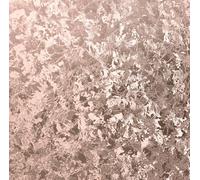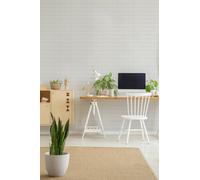Note: This text was created with the help of AI.








































- 1
- 2
- 3
- 4
- 5
- next page
Explore Exciting Offers on Wallpaper
Before wallpapering, you should clean up your walls. This means that you should sand down any unevenness and fill in any cracks or holes. But be careful: Too much filler can cause new unevenness here. This must be avoided.
Afterwards, a coat of wallpaper primer ensures better adhesion for subsequent wallpapering.
In order to carefully apply a strip of wallpaper, a little dexterity is required. To do this, let a strip of wallpaper stick out a little at the top and then press it on carefully. For this purpose, we recommend using a spatula or trowel or a paintbrush. This will make it easier for you to get no waves or air bubbles in the wallpaper. Then you only have to carefully cut off the protruding web with a cutter or simple scissors.
You can make small rooms appear larger with a few optical illusions. Striped wallpaper or wallpaper with a 3D effect are suitable for this. Stripes on the wall ensure that your eyes are distracted. So they unconsciously follow the stripes and no longer perceive the wall as a simple wall. Horizontal stripes give your room visual width, while vertical stripes make the walls appear higher.
Purely visually, you are also fooled by a 3D wallpaper. It makes a two-dimensional wall suddenly appear more three-dimensional, giving your brain the impression of a larger room. Very popular are three-dimensional wallpapers in stone optics, which give you the feeling of a real brickwork.
Regardless of whether you move house or not, you need to replace your wallpaper if it is permanently damp or if mould has formed. To ensure that your apartment always looks tidy, you can of course also wallpaper when cracks have formed in your wallpaper or when it is slowly peeling off by itself.
Not every wallpaper can be painted over. So if you want to change the wall colour afterwards without re-painting, you should choose one of the following wallpapers:
- Woodchip wallpaper.
- Paper wallpaper.
- Renovation & painter's fleece.
- 3D wallpaper.
A common cause of mould is high humidity and incorrect air circulation. You can prevent this with regular ventilation.
You should be careful behind furniture or curtains. While there is hardly any circulation behind curtains, liquid often collects unnoticed behind furniture, especially those that are never moved once installed (even to vacuum!), such as a wardrobe.
If you notice water damage in your house or apartment, contact your landlord immediately. Only immediate action can prevent mould on the walls in this case.
First try to remove the wallpaper dry from the wall. Only if this is no longer possible, other tools are used. To do this, work the wallpaper with a spiked roller to remove it more easily.
Afterwards you brush it with water or in hard cases with wallpaper solvent over, in order to soak the wallpaper. After a soaking time, you need a spatula to remove the wallpaper, but you should be very careful with it.
Old wallpaper is not recyclable. Therefore, you can dispose of used wallpaper in your rubbish bin.
Explore Exciting Offers on Wallpaper
If you're looking to add a touch of personality and style to your spaces, the variety of wallpaper options available on pricehunter.co.uk can be a game-changer. Whether you want to create a serene atmosphere or a bold statement, there's something for everyone. Let’s delve into the essential aspects of choosing the perfect wallpaper that fits your needs and preferences.Types of Wallpaper
When selecting wallpaper, understanding the types available can significantly influence your choice. From textured finishes to vibrant patterns, each type offers unique benefits.- Superfresco Easy - This is a popular choice for its easy application and removal.
- Vinyl Wallpaper - Durable and moisture-resistant, ideal for kitchens and bathrooms.
- Fabric Wallpaper - Adds a luxurious texture but may require more care.
- Paper Wallpaper - Eco-friendly but less durable than vinyl options.
- Peel and Stick - Perfect for renters or those looking for temporary changes.
Popular Wallpaper Brands
The brand you choose can also impact the overall quality and design of your wallpaper. Several brands have established themselves as leaders in the wallpaper industry, each with its unique offerings.- Graham Brown - Known for its stylish and contemporary designs.
- Holden Decor - Offers a wide variety of traditional and modern patterns.
- Joules - Features vibrant and playful designs inspired by nature.
- Superfresco - Renowned for user-friendly and innovative wallpaper solutions.
- Anaglypta - Specializes in textured wallpapers perfect for paint-over options.
Wallpaper Accessories
Investing in the right accessories can enhance the application and longevity of your wallpaper. Accessories often make the whole process smoother and more efficient.- Superfresco Easy Paste - A necessary tool for easy adhesion.
- Wallpaper Trimmer - Ensures clean edges and professional finishes.
- Seam Roller - Helps to press the wallpaper into place and eliminate air bubbles.
- Brushes and Rollers - Essential for applying paste or adhesive smoothly.
- Level and Measuring Tape - Important for precise alignment and cutting.
Usage Scenarios for Wallpaper
Choosing where to apply wallpaper is just as important as the design itself. Different rooms may require different styles and types of wallpaper based on their function and atmosphere.- Grey Damask - Perfect for creating an elegant atmosphere in dining rooms.
- Kids' Rooms - Bright and fun patterns can stimulate creativity and joy.
- Living Areas - Consider bold prints for an eye-catching focal point.
- Home Offices - Calming colors can enhance concentration and productivity.
- Bathrooms - Use moisture-resistant options to prevent damage.
Target Audiences for Wallpaper Options
Understanding who will benefit from specific wallpaper options can help you refine your choices. Different audiences have different needs based on lifestyle, preferences, and demographics.- Glitter Wallpaper - Ideal for young adults looking to add sparkle to their homes.
- Families - Durable and washable wallpapers are perfect for busy households.
- Renters - Temporary and removable wallpapers cater to those wanting flexibility.
- Interior Designers - Often seek unique patterns for client projects.
- Minimalists - Subtle designs and neutral colors can enhance simplicity.
Note: This text was created with the help of AI.